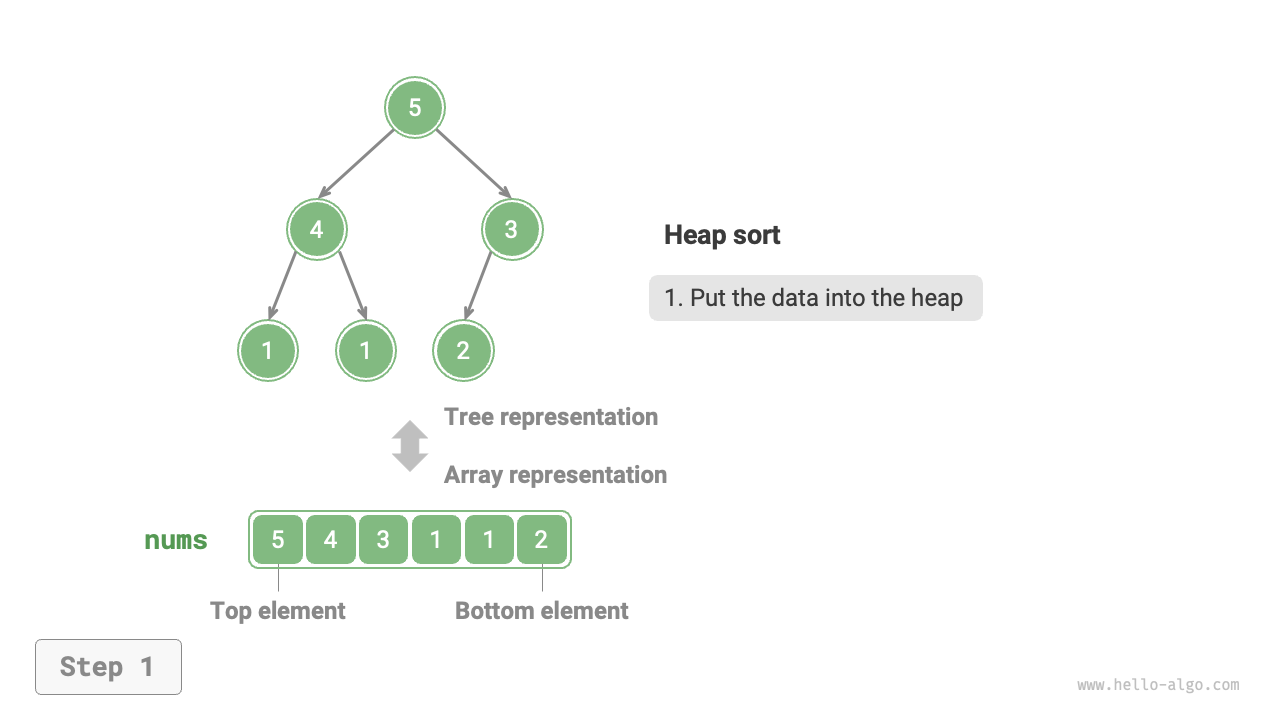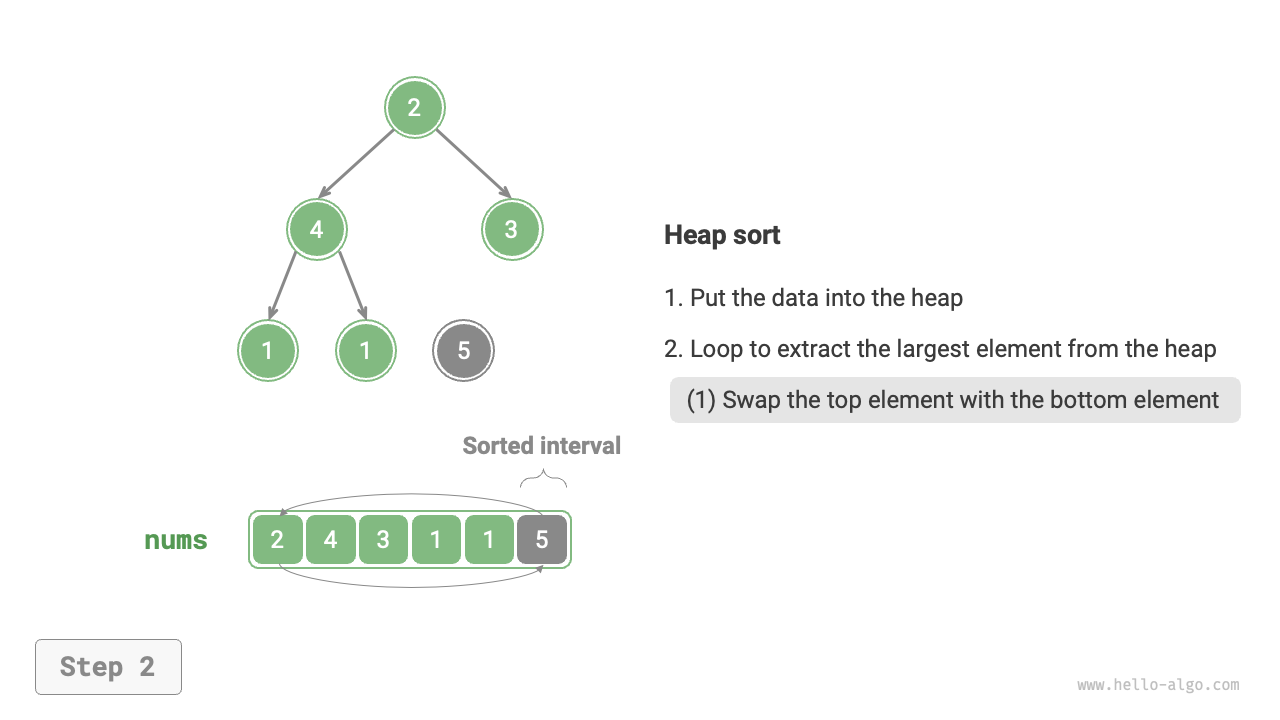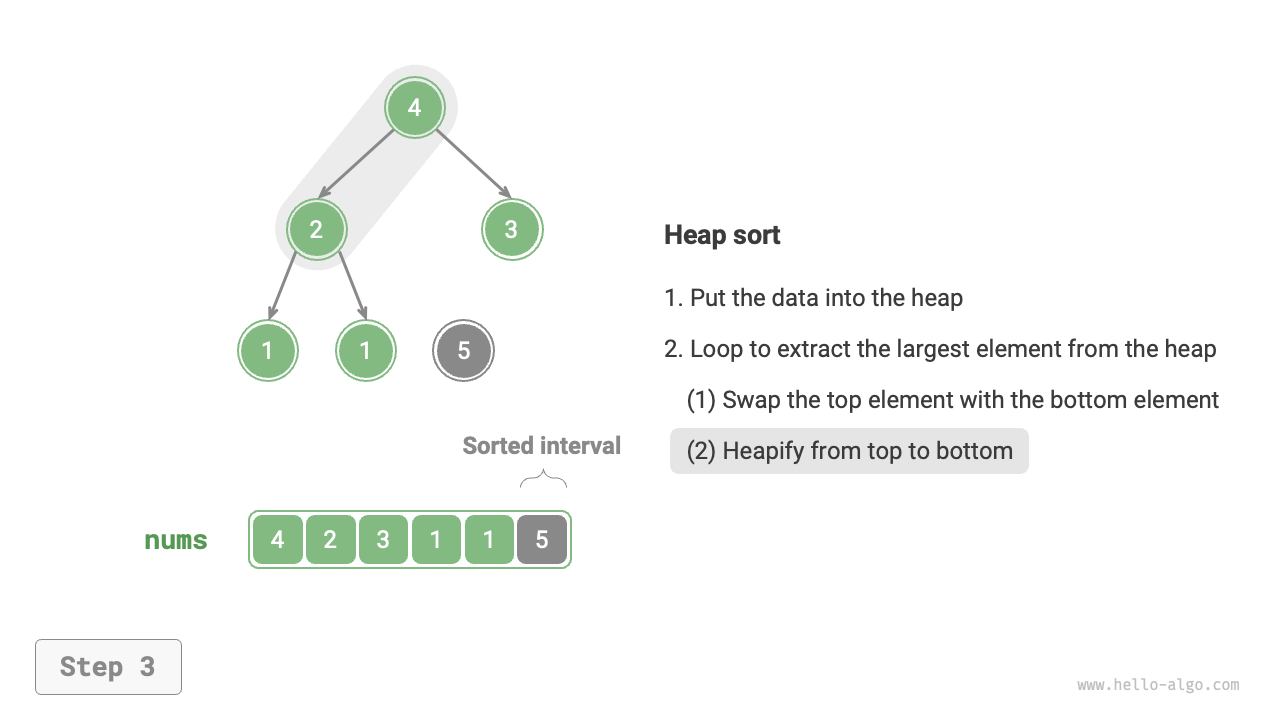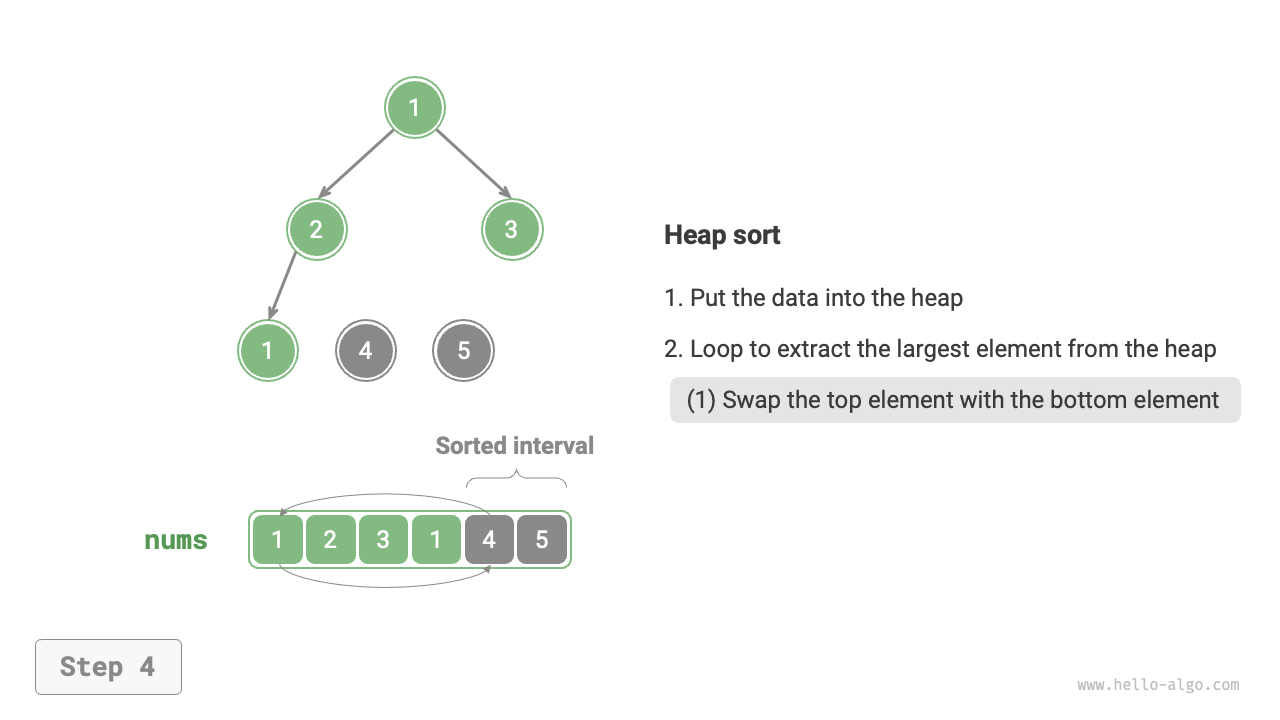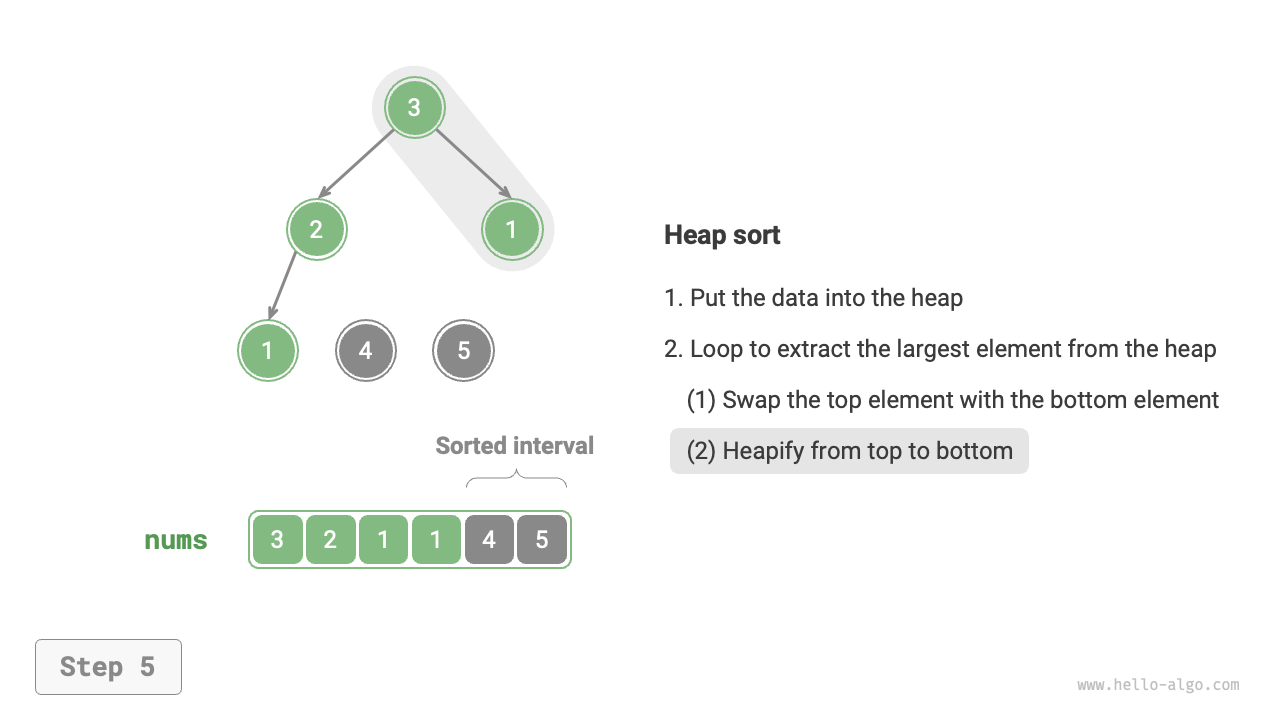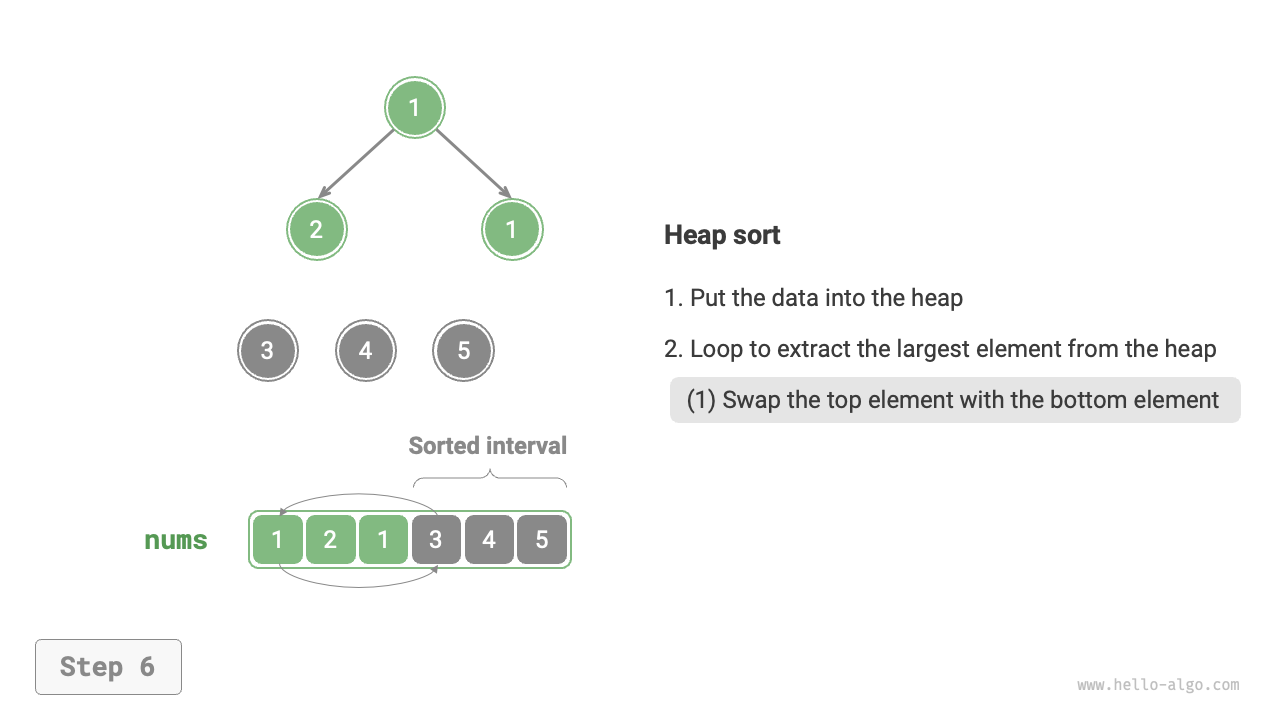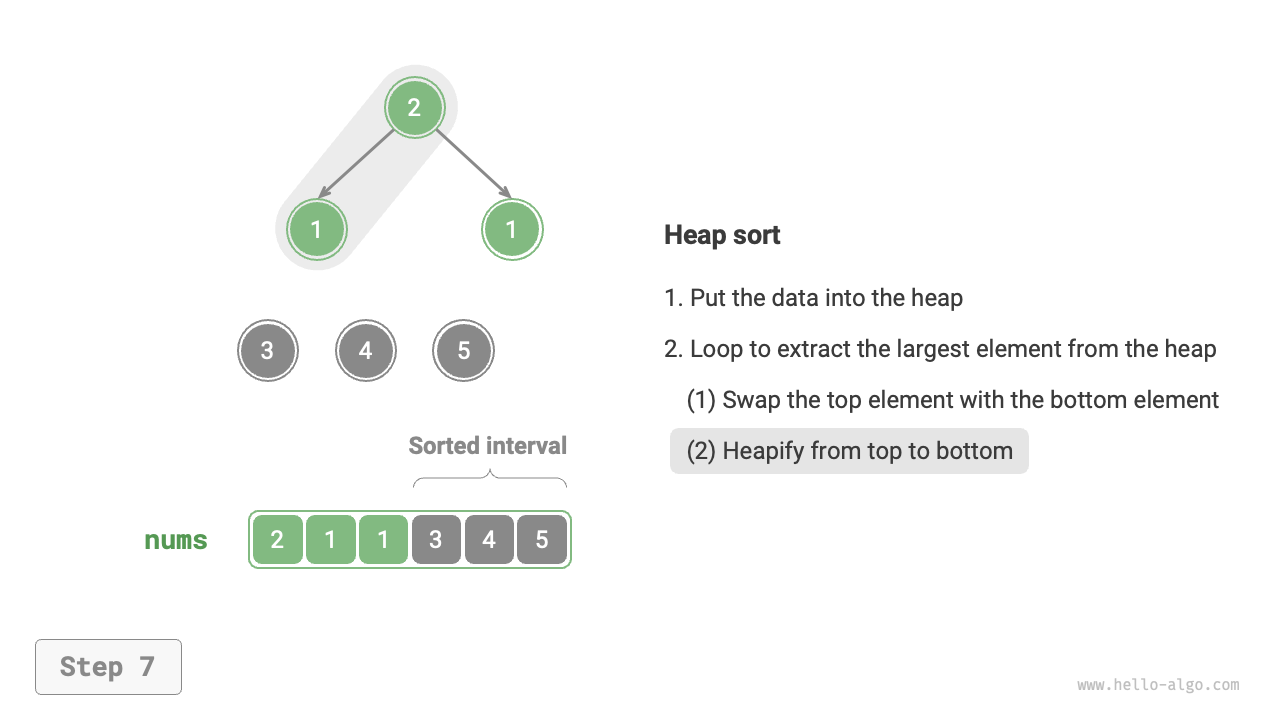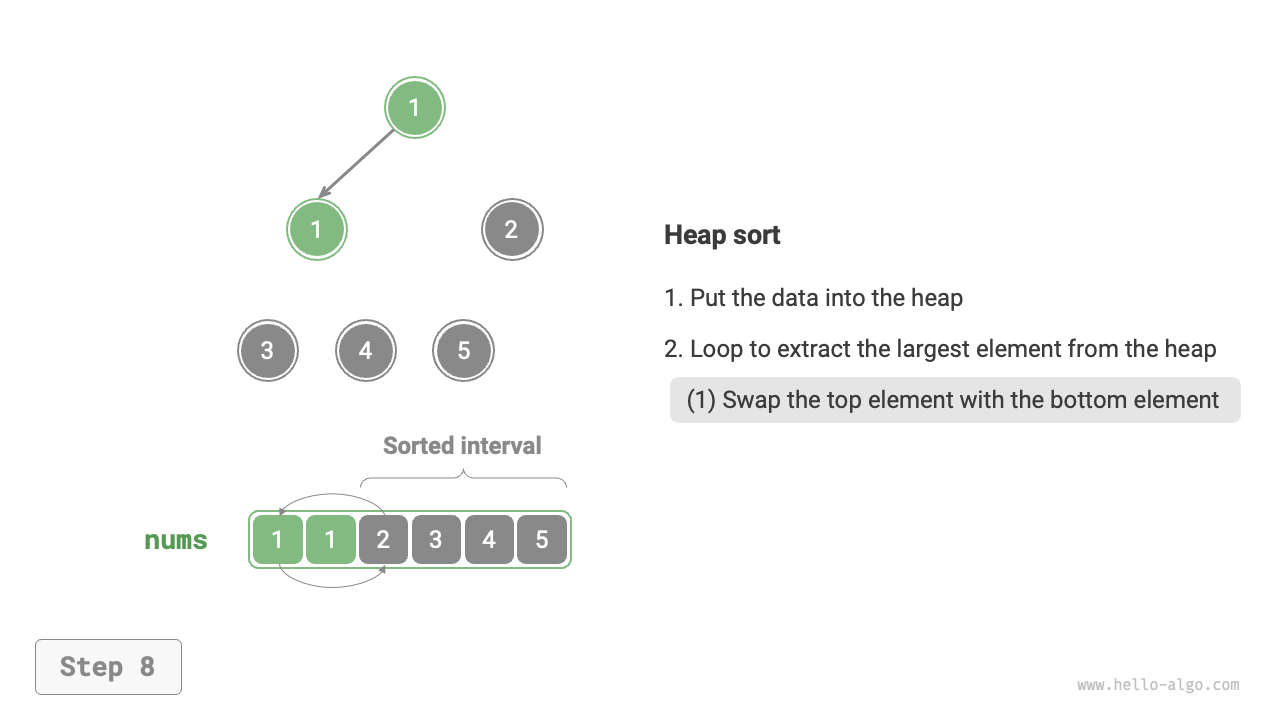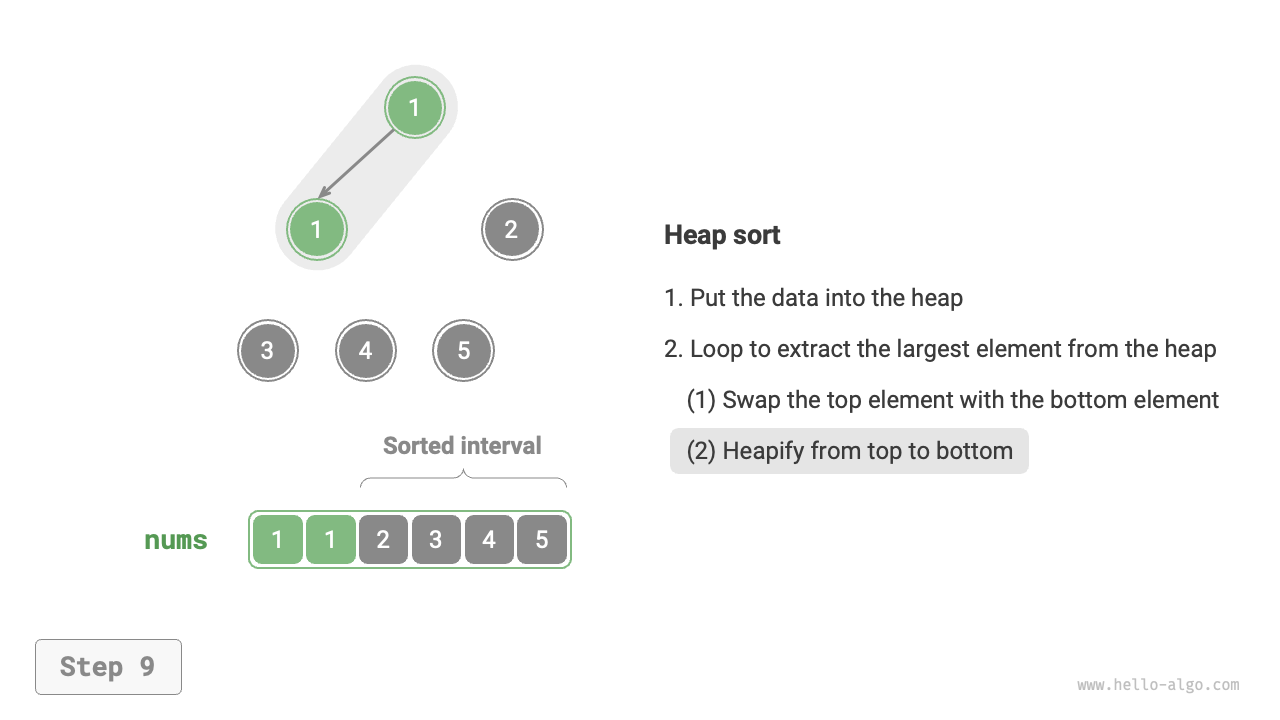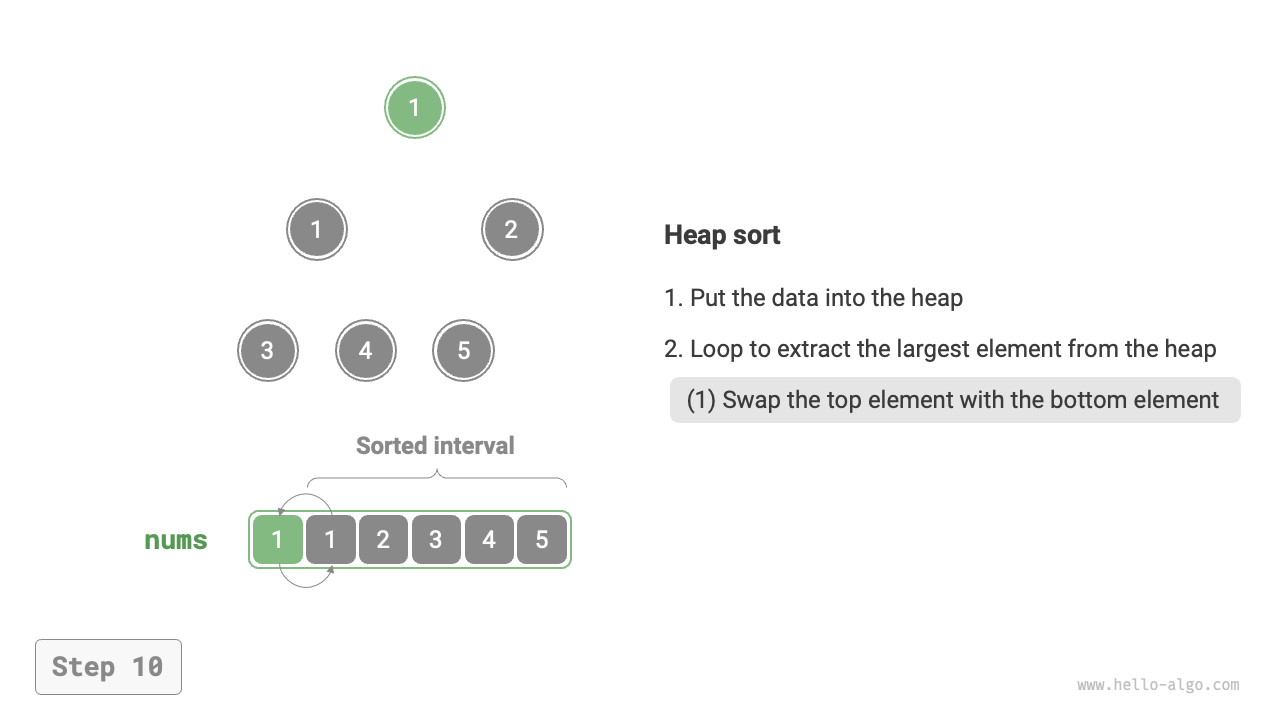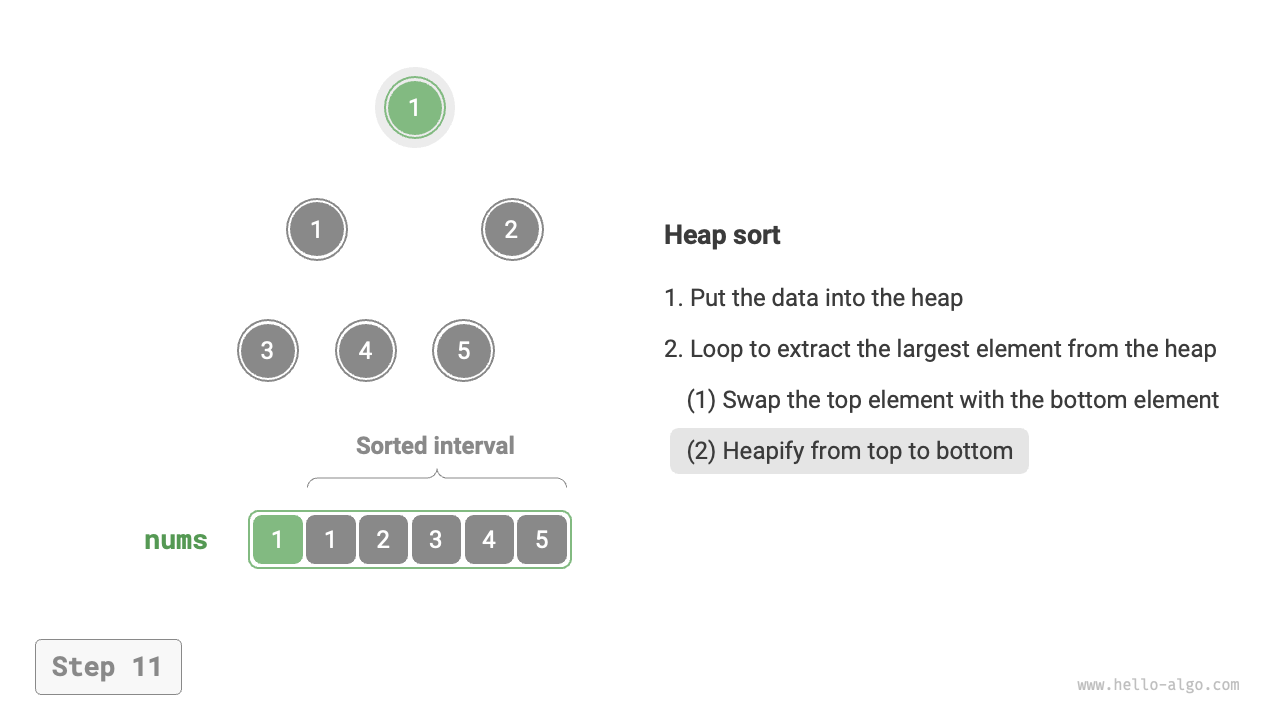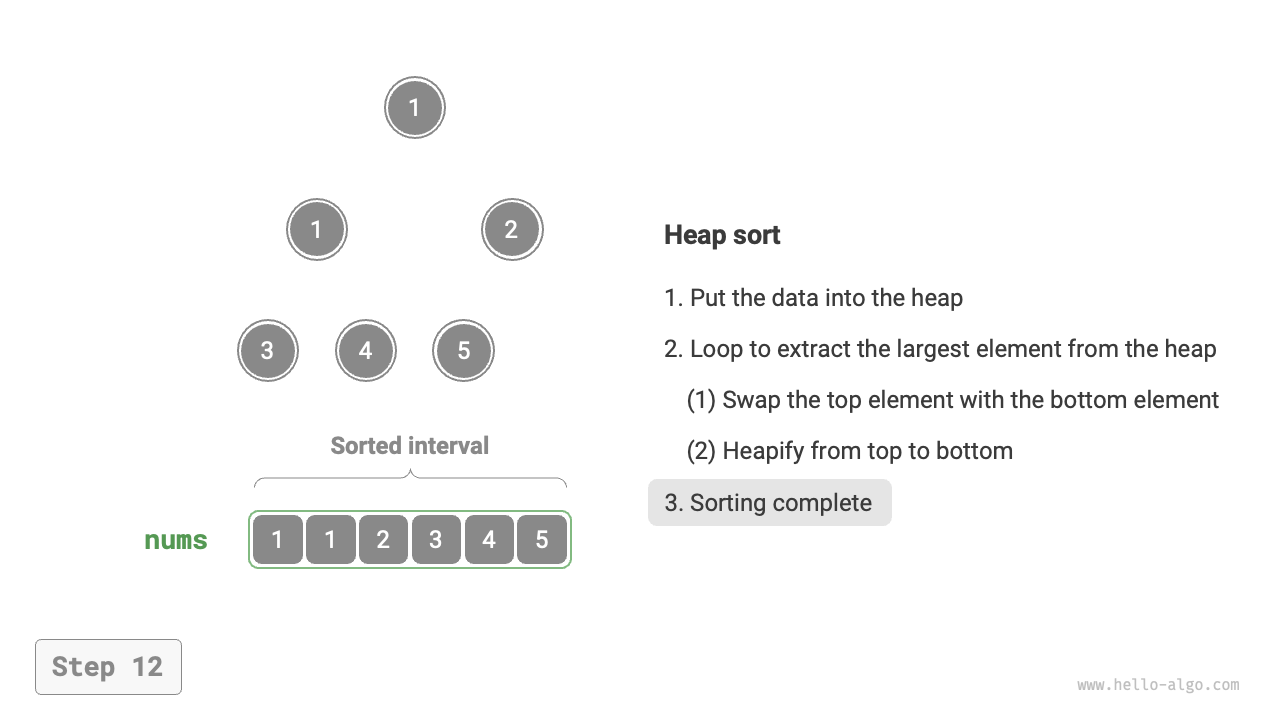11.7 Heap sort¶
Tip
Before reading this section, please ensure you have completed the "Heap" chapter.
Heap sort is an efficient sorting algorithm based on the heap data structure. We can implement heap sort using the "heap creation" and "element extraction" operations we have already learned.
- Input the array and construct a min-heap, where the smallest element is at the top of the heap.
- Continuously perform the extraction operation, record the extracted elements sequentially to obtain a sorted list from smallest to largest.
Although the above method is feasible, it requires an additional array to store the popped elements, which is somewhat space-consuming. In practice, we usually use a more elegant implementation.
11.7.1 Algorithm flow¶
Suppose the array length is \(n\), the heap sort process is as follows.
- Input the array and establish a max-heap. After this step, the largest element is positioned at the top of the heap.
- Swap the top element of the heap (the first element) with the heap's bottom element (the last element). Following this swap, reduce the heap's length by \(1\) and increase the sorted elements count by \(1\).
- Starting from the heap top, perform the sift-down operation from top to bottom. After the sift-down, the heap's property is restored.
- Repeat steps
2.and3.Loop for \(n - 1\) rounds to complete the sorting of the array.
Tip
In fact, the element extraction operation also includes steps 2. and 3., with an additional step to pop (remove) the extracted element from the heap.
Figure 11-12 Heap sort process
In the code implementation, we used the sift-down function sift_down() from the "Heap" chapter. It is important to note that since the heap's length decreases as the maximum element is extracted, we need to add a length parameter \(n\) to the sift_down() function to specify the current effective length of the heap. The code is shown below:
def sift_down(nums: list[int], n: int, i: int):
"""Heap length is n, start heapifying node i, from top to bottom"""
while True:
# Determine the largest node among i, l, r, noted as ma
l = 2 * i + 1
r = 2 * i + 2
ma = i
if l < n and nums[l] > nums[ma]:
ma = l
if r < n and nums[r] > nums[ma]:
ma = r
# If node i is the largest or indices l, r are out of bounds, no further heapification needed, break
if ma == i:
break
# Swap two nodes
nums[i], nums[ma] = nums[ma], nums[i]
# Loop downwards heapification
i = ma
def heap_sort(nums: list[int]):
"""Heap sort"""
# Build heap operation: heapify all nodes except leaves
for i in range(len(nums) // 2 - 1, -1, -1):
sift_down(nums, len(nums), i)
# Extract the largest element from the heap and repeat for n-1 rounds
for i in range(len(nums) - 1, 0, -1):
# Swap the root node with the rightmost leaf node (swap the first element with the last element)
nums[0], nums[i] = nums[i], nums[0]
# Start heapifying the root node, from top to bottom
sift_down(nums, i, 0)
/* Heap length is n, start heapifying node i, from top to bottom */
void siftDown(vector<int> &nums, int n, int i) {
while (true) {
// Determine the largest node among i, l, r, noted as ma
int l = 2 * i + 1;
int r = 2 * i + 2;
int ma = i;
if (l < n && nums[l] > nums[ma])
ma = l;
if (r < n && nums[r] > nums[ma])
ma = r;
// If node i is the largest or indices l, r are out of bounds, no further heapification needed, break
if (ma == i) {
break;
}
// Swap two nodes
swap(nums[i], nums[ma]);
// Loop downwards heapification
i = ma;
}
}
/* Heap sort */
void heapSort(vector<int> &nums) {
// Build heap operation: heapify all nodes except leaves
for (int i = nums.size() / 2 - 1; i >= 0; --i) {
siftDown(nums, nums.size(), i);
}
// Extract the largest element from the heap and repeat for n-1 rounds
for (int i = nums.size() - 1; i > 0; --i) {
// Swap the root node with the rightmost leaf node (swap the first element with the last element)
swap(nums[0], nums[i]);
// Start heapifying the root node, from top to bottom
siftDown(nums, i, 0);
}
}
/* Heap length is n, start heapifying node i, from top to bottom */
void siftDown(int[] nums, int n, int i) {
while (true) {
// Determine the largest node among i, l, r, noted as ma
int l = 2 * i + 1;
int r = 2 * i + 2;
int ma = i;
if (l < n && nums[l] > nums[ma])
ma = l;
if (r < n && nums[r] > nums[ma])
ma = r;
// If node i is the largest or indices l, r are out of bounds, no further heapification needed, break
if (ma == i)
break;
// Swap two nodes
int temp = nums[i];
nums[i] = nums[ma];
nums[ma] = temp;
// Loop downwards heapification
i = ma;
}
}
/* Heap sort */
void heapSort(int[] nums) {
// Build heap operation: heapify all nodes except leaves
for (int i = nums.length / 2 - 1; i >= 0; i--) {
siftDown(nums, nums.length, i);
}
// Extract the largest element from the heap and repeat for n-1 rounds
for (int i = nums.length - 1; i > 0; i--) {
// Swap the root node with the rightmost leaf node (swap the first element with the last element)
int tmp = nums[0];
nums[0] = nums[i];
nums[i] = tmp;
// Start heapifying the root node, from top to bottom
siftDown(nums, i, 0);
}
}
11.7.2 Algorithm characteristics¶
- Time complexity is \(O(n \log n)\), non-adaptive sort: The heap creation uses \(O(n)\) time. Extracting the largest element from the heap takes \(O(\log n)\) time, looping for \(n - 1\) rounds.
- Space complexity is \(O(1)\), in-place sort: A few pointer variables use \(O(1)\) space. The element swapping and heapifying operations are performed on the original array.
- Non-stable sort: The relative positions of equal elements may change during the swapping of the heap's top and bottom elements.
